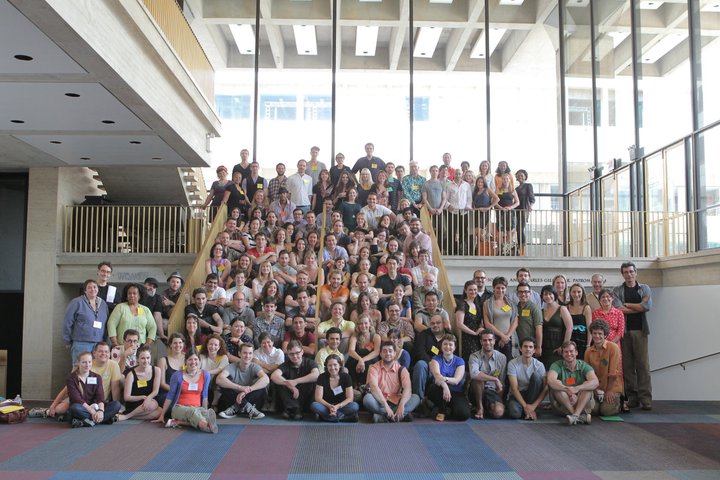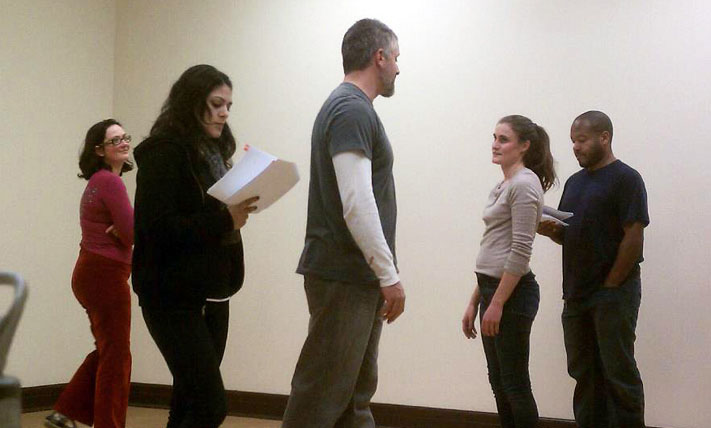In June of 2011, I participated in the Lincoln Center Directors Lab, where I learned a most interesting technique called Under-Reading and Emotional Release. I absorbed everything I could from English director Jemma Gross, who presented it in New York, came back home and read everything I could find about it.

Finally, armed with all the information I could stuff in my brain, I was ready to try it for myself in rehearsal, and it just happened that the next play I was directing was Green Whales, by Lia Romeo, a US West Coast Premiere that opened last week at Renegade Theatre Experiment in San Jose.
Developed over many years by the South African director Brian Astbury while teaching at LAMDA and Mountview Theatre School in London, Under-Reading and Emotional Release is a set of tools to help actors connect to the text and to their scene partners better, by doing two things: 1. liberating them from having to hold a script (the under-reading) and 2. liberating them from their body’s natural defenses (the emotional release). Astbury published his observations in the book Trusting the Actor – the title alone says it all.
It all has to do with the difference between the Left Brain and the Right Brain. The Left Brain is deliberate, calculated, slow. The Right Brain is impulsive, emotional, fast. An actor uses his or her Left Brain to read the lines, understand them, and attempt to interpret them. This is what we, in the business, call “being in your head”. It’s not very helpful. Those amazing moments when an actor connects so intensely with their character that they almost forget who they are, and what they say on stage is truthful, and incredibly captivating for the audience, are the moments when the Right Brain takes over. That’s what we strive for. Brian Astbury explains it in his lectures: “Which would you rather controlled your acting: the Left Brain with its pathetic inability to hold more than seven bytes of information at any one moment? Or the Right Brain, which can take squillions of decisions in the blink of an eye? There is, of course, no contest.”
Under-Reading, Theory and Practice
The first part of Brian Astbury’s approach is the simple fact of not holding a script. Each actor has a person called “the under-reader” (another actor, or stage management) who stands close behind them and feeds them their lines 3-7 words at a time – trying to keep sentences intact – as if they are a voice in the actor’s head. The actor then repeats what they hear as part of the scene. Why 3-7 words at a time? Because, as mentioned above, the human Left Brain can only hold about 7 – let’s call them bytes – of information at any one time.
What does this do for you if you’re an actor? You no longer have to hold a script, so your hands are free; you no longer have to look at a script, so your eyes are free to make eye contact with your partner; and most importantly, you no longer have to read a script; hearing the lines from behind, without seeing the person who delivers them, feels almost like they are your own thoughts, no matter the timbre of the voice.
What does this do for you if you’re a director? Your actors will make choices about their characters a lot sooner in the rehearsal process; and they will have time and freedom to change those choices until they find the one that feels right. You will discover things about the text that, with all your research and preparation, you didn’t notice before; I promise you this. Your actors will be off-book sooner. Your cast will feel more like an ensemble, because each actor will naturally connect with their under-reader, having been placed in a relationship of mutual trust.
Eager to try it out, and wanting to make sure that the actors I cast in Green Whales were willing to work with me using this new approach, I used under-reading in auditions. I had the help of casting director Caitlin McGarty and RTE ensemble member Howard Miller as under-readers. To my delight, all actors were happy to try it. I was careful to explain to them that the reason for using under-reading in audition was to help them, not to trick them, and I allowed each actor to try it out once before the official beginning of audition.
The results were inspiring. Those actors who were naturally comfortable with their emotions and who trusted me and the technique, sparkled. Sparkled! Those actors whose defenses kicked in strongly, but tried their best to trust me, still had some very good connections to the text and some unexpected choices. The only actor for whom the experience did not work was the actor who memorized the audition scene the night before, although I had asked everybody not to. He tried to listen to his under-reader but couldn’t, as his Left Brain was busy blurting out memorized words while making him physically stiff.

Based on the success of under-reading in audition, you can imagine rehearsals went extremely well. Since this was my first time holding rehearsals in this manner, it was a huge learning experience. I remember telling my husband in the first week of rehearsals that I feel strange in my leadership role (especially during emotional release exercises, more on this in the next post), being the person of authority in the room, when really I was learning alongside the actors. This, of course, turned out to be a blessing. A wonderful feeling of trust and camaraderie webbed itself between us as an ensemble, as well as between each individual actor and me. The more trust from each of us, the stronger the bond. I can safely say that I have never been as attached to a cast as I am to the cast and stage manager of Green Whales.
In my next post, I describe Emotional Release and some of my experience with it.